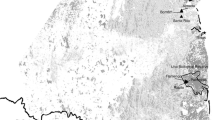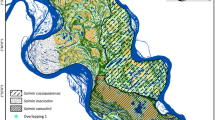Abstract
Niche separation is likely to play a key role in the formation of mixed-species groups. Saddle-backed tamarins (Saguinus fuscicollis) were studied at three sites with different primate communities in northern Bolivia: (1) with red-bellied tamarins,S. labiatus; (2) with emperor tamarins,S. imperator; and (3) without a congeneric species. The degree of association is higher betweenS. labiatus andS. fuscicollis than betweenS. imperator andS. fuscicollis and is related to differences in forest utilization between associating pairs. Niche separation is found to be greater betweenS. labiatus andS. fuscicollis than betweenS. fuscicollis andS. imperator. The mean height and habitat utilization ofS. fuscicollis does not differ greatly across the three sites, nor does the height of tamarins in and out of association. It is concluded that combined with differences in body size and dietary overlap, vertical segregation plays an important role in tamarin polyspecific associations (increasing the potential of both foraging and anti-predatory benefits) and that this is not a consequence of vertical displacement ofS. fuscicollis by its dominant congeners.
Similar content being viewed by others
References
Bshary, R.;Noe, R. 1997. Red colobus and Diana monkeys provide mutual protection against predators.Anim. Behav., 54: 1461–1474.
Buchanan-Smith, H. M. 1989. The social organisation and mating system of the red-bellied tamarins (Saguinus labiatus labiatus): behavioural observations in captivity and in the wild. Unpubl. Ph.D. thesis, Univ. of Reading, Reading, U. K.
Buchanan-Smith, H. M. 1990. Polyspecific association of two tamarin species,Saguinus labiatus andSaguinus fuscicollis, in Bolivia.Amer. J. Primatol., 22: 205–214.
Buchanan-Smith, H. M. 1991. A field study of the red-bellied tamarin,Saguinus l. labiatus, in Bolivia.Int. J. Primatol., 12: 259–276.
Buchanan-Smith, H. M.;Hardie, S. M. 1997. Tamarin mixed-species groups: an evaluation of a combined captive and field approach.Folia Primatol., 68: 272–286.
Castro, C. N. R. 1991. Behavioral ecology of two coexisting tamarin species (Saguinus fuscicollis nigrifrons andSaguinus mystax mystax, Callitrichidae, Primates) in Amazonian Peru. Unpubl. Ph.D. thesis, Washington Univ., St Louis.
Charles-Dominique, P. 1977.Ecology and Behaviour of Nocturnal Primates, Prosimians of Equatorial West Africa. Columbia Univ. Press, New York.
Cords, M. 1987. Mixed-species association ofCercopithecus monkeys in the Kakamega Forest, Kenya.Univ. of California Publ. Zool., 117: 1–109.
Cords, M. 1990. Mixed-species association of east African guenons: general patterns or specific examples.Amer. J. Primatol., 21: 101–114.
Emmons, L. H. 1980. Ecology and resource partitioning among nine species of African rain forest squirrels.Ecol. Monogr., 50: 31–54.
Fang, T. G. 1990. La importancia de los frutos en la dieta deSaguinus mystax yS. fuscicollis (Primates, Callitrichidae) en el río Tahuyao, Departamento de Loreto, Perú. In:La Primatología en el Perú: Investigaciones Primatológicas (1973–1985),Dirección General Forestal y de Fauna, Instituto Veterinario de Investigaciones Tropicales y de Altura, Organización Panamericana de Salud (ed.), Imprenta Propacep, Lima, pp. 342–358.
Garber, P. A. 1988. Diet, foraging patterns and resource defense in a mixed-species troop ofSaguinus mystax andSaguinus fuscicollis in Amazonian Peru.Behaviour, 105: 18–34.
Garber, P. A. 1991. A comparative study of positional behavior in three species of tamarin monkeys.Primates, 32: 219–230.
Garber, P. A. 1992. Vertical clinging, small body size, and the evolution of feeding adaptations in the Callitrichidae.Amer. J. Phys. Anthropol., 88: 469–482.
Garber, P. A.;Pruetz, J. D. 1995. Positional behavior in moustached tamarin monkeys: effects of habitat on locomotor variability and locomotor stability.J. Human Evol., 28: 411–426.
Gautier-Hion, A. 1978. Food-niches and co-existence in sympatric primates in Gabon. In:Recent Advances in Primatology, Vol. 1: Behaviour,Chivers,D. J.;Herbert,J. (eds.), Academic Press, New York, pp. 269–286.
Gautier-Hion, A. 1988. Polyspecific associations among forest guenons: ecological, behavioural and evolutionary aspects. In:A Primate Radiation: Evolutionary Biology of the African Guenons,Gautier-Hion,A.;Bouliere,F.;Gautier,J. P.;Kingdon,J. (eds.), Cambridge Univ. Press, Cambridge, pp. 452–475.
Goldizen, A. W. 1988. Tamarin and marmoset mating systems: unusual flexibility.Trends Ecol. Evol., 3: 36–40.
Hardie, S. M. 1998. Mixed-species tamarin groups (Saguinus fuscicollis andSaguinus labiatus) in northern Bolivia.Primate Rep., 50: 39–62.
Hardie, S. M.;Buchanan-Smith, H. M. 1997. Vigilance in single- and mixed-species groups of tamarins (Saguinus labiatus andSaguinus fuscicollis).Int. J. Primatol., 18: 219–232.
Heymann, E. W. 1990. Interspecific relations in a mixed-species troop of moustached tamarins,Saguinus mystax, and saddle-back tamarins,Saguinus fuscicollis (Primates: Callitrichidae), at the Rio Blanco, Peruvian Amazonia.Amer. J. Primatol., 21: 115–127.
Heymann, E. W. 1997. The relationship between body-size and mixed-species troops of tamarins (Saguinus spp.).Folia Primatol., 68: 287–296.
Hinde, R. A. 1973. On the design of check-sheets.Primates, 14: 393–406.
Keddy, P. A. 1989.Competition. Chapman & Hall, London.
MacKinnon, J.;MacKinnon, K. 1978. Comparative feeding ecology of six sympatric primates in West Malaysia. In:Recent Advances in Primatology, Vol. 1: Behaviour,Chivers,D. J.;Herbert,J. (eds.), Academic Press, New York, pp. 305–321.
Nickle, D. A.;Heymann, E. W. 1996. Predation on Ortoptera and other orders of insects by tamarin monkeys,Saguinus mystax mystax andSaguinus fuscicollis nigrifrons (Primates: Callitrichidae), in north-eastern Peru.J. Zool., Lond., 239: 799–819.
Norconk, M. A. 1986. Interactions between primate species in a neotropical forest: mixed-species troops ofSaguinus mystax andS. fuscicollis (Callitrichidae). Unpubl. Ph.D. thesis, Univ. of California, Los Angeles.
Norconk, M. A. 1990. Mechanisms promoting stability in mixedSaguinus mystax andS. fuscicollis troops.Amer. J. Primatol., 21: 159–170.
Oates, J. F.;Whitesides, G. H. 1990. Association between olive colobus (Procolobus vera), Diana guenons (Cercopithecus diana), and other forest monkeys in Sierra Leone.Amer. J. Primatol., 21: 129–146.
Peres, C. A. 1992. Prey-capture benefits in a mixed-species group of Amazonian tamarins,Saguinus fuscicollis andS. mystax.Behav. Ecol. Sociobiol., 31: 339–347.
Peles, C. A. 1993a. Diet and feeding ecology of saddle-back (Saguinus fuscicollis) and moustached (S. mystax) tamarins in the Amazonian terra firme forest.J. Zool., Lond., 230: 567–592.
Peres, C. A. 1993b. Anti-predator benefits in a mixed-species group of Amazonian tamarins.Folia Primatol., 61: 61–76.
Peres, C. A. 1996. Food patch structure and plant resource partitioning in inter-specific associations of Amazonian tamarins.Int. J. Primatol., 17: 695–723.
Pook, A.;Pook, A. G. 1982. Polyspecific association betweenSaguinus fuscicollis, Saguinus labiatus, Callimico goeldii and other primates in North Western Bolivia.Folia Primatol., 38: 196–216.
Richard, A. F. 1985.Primates in Nature. W. H. Freeman, San Francisco.
Rylands, A. B.;Mittermeier, R. A.;Rodríguez Luna, E. 1995. A species list for the New World primates (Platyrrhini): distribution by country, endemism, and conservation status according to the Mace-Lande system.Neotropical Primates, 3 (suppl.): 113–160.
Schoener, T. W. 1988. Ecological interactions. In:Analytical Biogeography,Myers,A. A.;Giller,P. S. (eds.), Chapman & Hall, London, pp. 255–297.
Smith, A. C. 1997. Comparative ecology of saddle-back (Saguinus fuscicollis) and moustached (Saguinus mystax) tamarins. Unpubl. Ph.D. thesis, Univ. of Reading, Reading, U.K.
Soini, P. 1987. Ecology of the saddle-backed tamarins,Saguinus fuscicollis illigeri on the Rio Pacaya, northeastern Peru.Folia Primatol., 49: 11–32.
Struhsaker, T. T. 1978. Food habits of five monkeys species in the Kibale forest Uganda. In:Recent Advances in Primatology, Vol. 1: Behaviour,Chivers,D. J.;Herbert,H. (eds.), Academic press, New York, pp. 225–248.
Terborgh, J. 1983.Five New World Primates: A Study of Comparative Ecology. Princeton Univ. Press, Princeton.
Wachter, B.;Schabel, M.;Noe, R. 1997. Diet overlap and polyspecific associations of red colobus and Diana monkeys in the Taï National Park, Ivory Coast.Ethology, 103: 514–526.
Whitesides, G. H. 1989. Interspecific associations of Diana monkeys,Cercopithecus diana, in Sierra Leone, West Africa: biological significance or chance?Anim. Behav., 30: 1–8.
Windfelder, T. L. 1997. Polyspecific association and inter-specific communication between two neotropical primates: saddle-back tamarins (Saguinus fuscicollis) and emperor tamarins (Saguinus imperator). Unpubl. Ph.D. thesis, Duke Univ., North Carolina.
Yoneda, M. 1981. Ecological studies ofSaguinus fuscicollis andSaguinus labiatus with reference to habitat segregation and height preference. In:Kyoto Univ. Overseas Res. Rep. of New World Monkeys, pp. 43–50.
Yoneda, M. 1984. Comparative studies on vertical separation, foraging behaviour and traveling mode of saddle-backed tamarins (Saguinus fuscicollis) and red-chested moustached tamarins (Saguinus labiatus) in northern Bolivia.Primates, 25: 414–422.
Author information
Authors and Affiliations
About this article
Cite this article
Buchanan-Smith, H.M. Tamarin polyspecific associations: Forest utilization and stability of mixed-species groups. Primates 40, 233–247 (1999). https://doi.org/10.1007/BF02557713
Received:
Accepted:
Issue Date:
DOI: https://doi.org/10.1007/BF02557713




